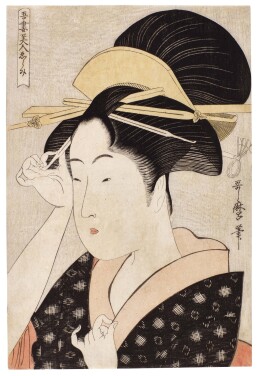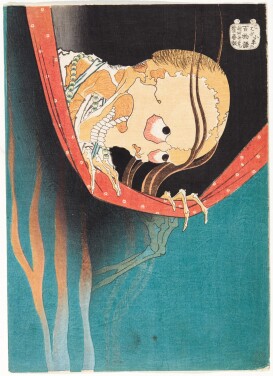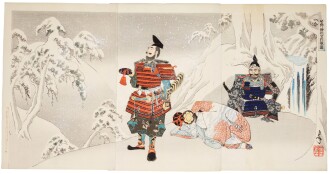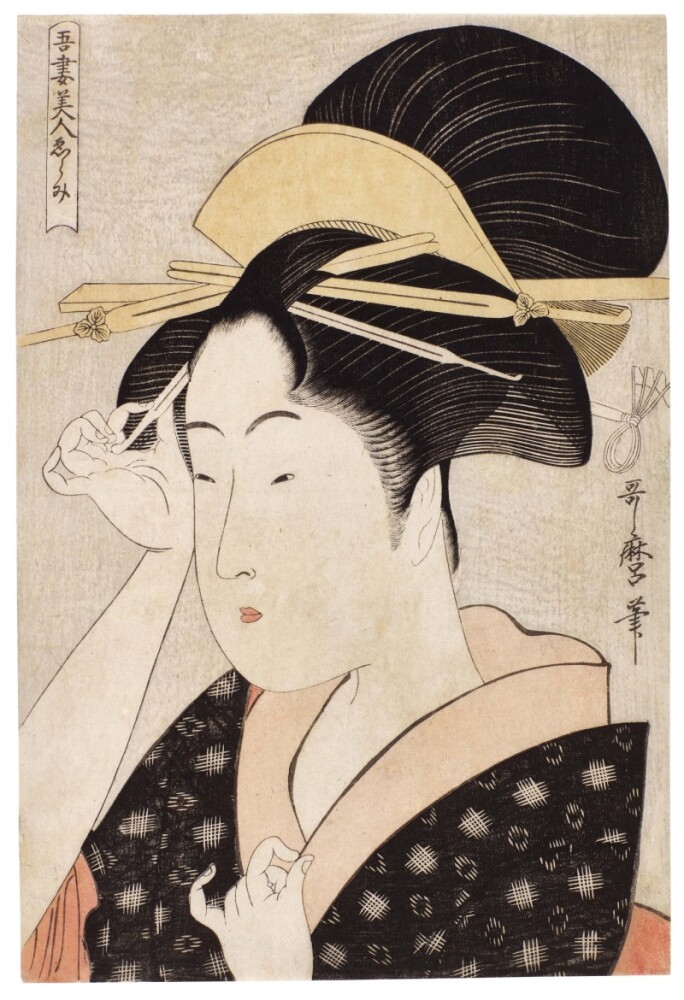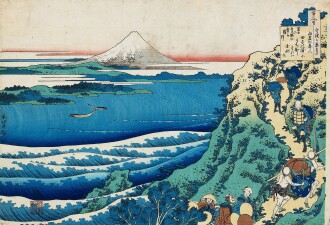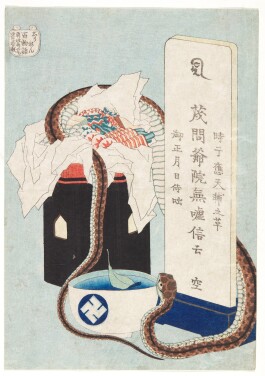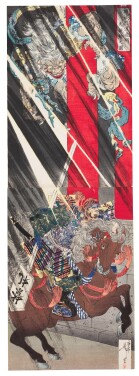W e are delighted to announce the sale of a Private Collection of Fine Japanese Prints, including woodblock prints by Toshusai Sharaku, Katsushika Hokusai, Kitagawa Utamaro and Tsukioka Yoshitoshi. Among this group is Sharaku’s expressive and dramatic depiction of the Actor Otani Tokuji in the role of the Servant Sodesuke and two elegant depictions of beauties by Utamaro. A large group of Hokusai prints complement these works, including two impressions from Hokusai’s sinister One Hundred Ghost Tales (Hyaku monogatari), their iconography rich in legendary folklore. Also included are a group of prints from the series One Hundred Poems Explained by the Nurse (Hyakunin isshu uba ga etoki), coloured in lively hues, and a selection of thirteen prints from the series Thirty-Six Views of Mount Fuji (Fugaku sanjurokkei). The sale concludes with several vibrant triptychs by Yoshitoshi.
Featured Highlights

The Japan Ukiyo-e Museum was established in 1982 by three brothers, Tokichi, Teisuke and Senzaburou Saikai, as a means of publicly displaying the family’s large collection of ukiyo-e prints, paintings, scrolls, modern prints and antiquarian books, and to contribute towards these fields of study.
The collection was founded by Yoshiaki Sakai (1776-1842) during the first half of the nineteenth century, an important merchant and patron of the arts in Matsumoto. In 1836 Yoshiaki commissioned the renowned ukiyo-e artist, Utagawa Hiroshige, to paint his portrait. His son Yoshitaka (1810-1869) and grandson Touhyou-u (1844-1911) continued in his footsteps, the latter opening a gallery in Tokyo in 1870 and encouraging scholarly research into ukiyo-e, an activity also advocated by Shoukichi (1915-1993) who founded the academic periodical “Ukiyo-e”. The Sakai collection has travelled around the world and has been exhibited in Europe, the USA, Australia, the Middle East, China and South America.

- Lot 12
KATSUSHIKA HOKUSAI (1760-1849) YOSHIDA ON THE TOKAIDO (TOKAIDO YOSHIDA) | EDO PERIOD, 19TH CENTURY
Woodblock print, from the series Thirty-six Views of Mount Fuji (Fugaku sanjurokkei), signed saki no Hokusai litsu hitsu, published by Nishimuraya Yohachi (Eijudo), circa 1830–33
Horizontal oban:
26 x 38.2 cm, 10¼ x 15⅛ in.
10,000 - 15,000 GBP
- Lot 6
woodblock print, from the series Thirty-six Views of Mount Fuji (Fugaku sanjurokkei), signed Hokusai aratame Iitsu hitsu, published by Nishimuraya Yohachi (Eijudo), no publisher's mark, blue outline, circa 1830–31
Horizontal oban:
25.3 x 37 cm, 10 x 14⅝ in.
15,000 - 20,000 GBP
- Lot 7
KATSUSHIKA HOKUSAI (1760-1849) THE WATERWHEEL AT ONDEN (ONDEN NO SUISHA) | EDO PERIOD, 19TH CENTURY
woodblock print, from the series Thirty-six Views of Mount Fuji (Fugaku sanjurokkei), signed saki no Hokusai litsu hitsu, published by Nishimuraya Yohachi (Eijudo), censor's seal kiwame, publisher's mark Eijudo, blue outline, circa 1832
Horizontal oban:
26.3 x 38.7 cm, 10⅜ x 15¼ in.
15,000 - 20,000 GBP
- Lot 15
Woodblock print, from the series Thirty-six Views of Mount Fuji (Fugaku sanjurokkei), signed saki no Hokusai litsu hitsu, published by Nishimuraya Yohachi (Eijudo), censor's seal kiwame, publisher's mark Eijudo, circa 1831
Horizontal oban:
24.9 x 37.3 cm, 9⅞ x 14¾ in.
4,000 - 6,000 GBP
- Lot 14
Signed saki no Hokusai litsu hitsu, published by Nishimuraya Yohachi (Eijudo), censor's seal kiwame and publisher's mark, circa 1830–31
Horizontal oban:
25.8 x 38.4 cm, 10⅛ x 15⅛ in.
10,000 - 15,000 GBP
- Lot 11
Woodblock print, from the series Thirty-six Views of Mount Fuji (Fugaku sanjurokkei), signed saki no Hokusai litsu hitsu, published by Nishimuraya Yohachi (Eijudo), no publisher's mark, circa 1833
Horizontal oban:
25.5 x 37.8 cm, 10 x 14⅞ in.
5,000 - 8,000 GBP
- Lot 8
KATSUSHIKA HOKUSAI (1760-1849) OWER MEGURO (SHIMO-MEGURO) | EDO PERIOD, 19TH CENTURY
Woodblock print, from the series Thirty-six Views of Mount Fuji (Fugaku sanjurokkei), signed saki no Hokusai litsu hitsu, published by Nishimuraya Yohachi (Eijudo), censor's seal kiwame, publisher's mark Eijudo, circa 1830–31
Horizontal oban:
25.2 x 37.5 cm, 10⅛ x 14⅞ in.
10,000 - 15,000 GBP
- Lot 10
woodblock print, from the series Thirty-six Views of Mount Fuji (Fugaku sanjurokkei), signed saki no Hokusai litsu hitsu, published by Nishimuraya Yohachi (Eijudo), censor's seal kiwame, publisher's mark Eijudo, blue outline, circa 1830–31
Horizontal oban:
25.4 x 37 cm , 10 x 14⅝ in.
12,000 - 18,000 GBP
Utamaro’s Bijin
These two elegant depictions of beautiful women (bijin) are prime examples of Kitagawa Utamaro’s oeuvre, which concentrated on the graceful rendering of ladies of the pleasure district undertaking a variety of daily activities relating to their toilette, from combing their hair to applying make-up.
Here, as in many of his later works, Utamaro depicted individual portraits of bijin, concentrating on the upper half of their physique (okubi-e) and accentuating, and often distorting to greater effect, their fine female features. Images of bijin were extremely popular and demand for the subject-matter blossomed during the Edo period, with the extensive circulation of bijin prints greatly facilitated by their medium.

For his last single sheet series of woodblock prints, One Hundred Poems Explained by the Nurse (Hyakunin isshu uba ga etoki), Katshushika Hokusai looked to an anthology of well-known poems, entitled Hyakunin Isshu (A Hundred Poems by a Hundred Poets), as his source. These poems, based on love and melancholy, were assembled by the thirteenth-century poet Fujiawara no Teika. Hokusai chose to visually recount the poems from the perspective of a fictional elderly nurse, thereby injecting a mixture of emotion, empathy and humour into his imagery. Together with sixty-four preparatory drawings, twenty-seven published prints are known, each exhibiting bold and brilliant colours and including a cartouche enclosing the relevant verse.

The visual representation of the spiritual world and its legends played a key role within the realm of ukiyo-e. Ghost stories, the subject of great fascination in Japan from the Edo period onwards, were recounted over candlelight, and provided the inspiration for Katshushika Hokusai’s haunting prints from his series One Hundred Ghost Tales (Hyaku monogatari) from 1833. Half a century later, Tsukioka Yoshiotshi employed the print medium to illustrate his colourful and dramatic vision of the spectral world, often depicting ghosts and demons at the hands of warriors.
